 On October 7, 1952 Bernard Silver and Norman Joseph Woodland received US Patent 2,612,994 for “Classifying Apparatus and Method.”
On October 7, 1952 Bernard Silver and Norman Joseph Woodland received US Patent 2,612,994 for “Classifying Apparatus and Method.”
In 1948, Bernard Silver, then a graduate student at Drexel University, overheard a conversation that would eventually lead to the development of the bar code. The president of a local food chain was looking for a system that would automatically read information during the check out process. Silver told another graduate student, Norman Joseph Woodland about the conversation and they began working on solutions.
Their first working system used patterns of ink that glowed under ultraviolet light. The ultraviolet ink had problems with stability and was extremely expensive to print. Still, Woodland was convinced that he had a workable idea. In order to have more time to work on the project, he quit Drexel, sold some stock and moved in with his grandfather in Florida. Continue reading “Invention of the Bar Code Patented: Saving You Time at Checkout”

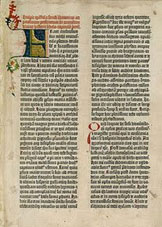 According to traditional dating, on September 30, 1452, Johann Gutenberg’s began printing his Bible which became the first book to be published in volume. The Bible, known as the 42-line Bible because there were 42 lines on each page, was very large consisting of 1280 pages. The Latin words were printed in black ink and then an illustrator added colorful designs in the margin. Two hundred copies of the two-volume Gutenberg Bible were printed, a small number of which were printed on vellum. 48 copies of this bible are known to still exist today.
According to traditional dating, on September 30, 1452, Johann Gutenberg’s began printing his Bible which became the first book to be published in volume. The Bible, known as the 42-line Bible because there were 42 lines on each page, was very large consisting of 1280 pages. The Latin words were printed in black ink and then an illustrator added colorful designs in the margin. Two hundred copies of the two-volume Gutenberg Bible were printed, a small number of which were printed on vellum. 48 copies of this bible are known to still exist today.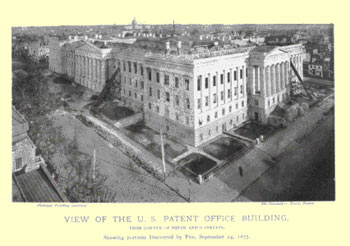 The Patent Office had its second fire on September 24, 1877. This fire happened in the new “fire-proof” building whose construction had begun in 1836. The building was fireproof but the contents were anything but.
The Patent Office had its second fire on September 24, 1877. This fire happened in the new “fire-proof” building whose construction had begun in 1836. The building was fireproof but the contents were anything but. The monetary lose was much worse than that of the fire in 1836. For months after the fire, great efforts were made at a very high cost to replace the artifacts. Of the 114,000 models that were housed in the building, 87,000 were destroyed. 600,000 prints of original drawings were lost and had to be reprinted. Original drawings and models of 31 patents were destroyed. These were restored using only the specifications. Ultimately though, no patents were completely lost in the fire.
The monetary lose was much worse than that of the fire in 1836. For months after the fire, great efforts were made at a very high cost to replace the artifacts. Of the 114,000 models that were housed in the building, 87,000 were destroyed. 600,000 prints of original drawings were lost and had to be reprinted. Original drawings and models of 31 patents were destroyed. These were restored using only the specifications. Ultimately though, no patents were completely lost in the fire.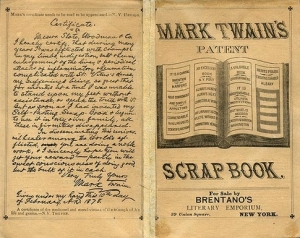
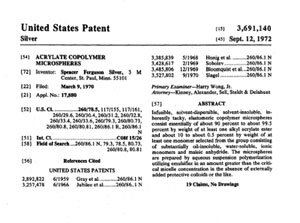 Sometimes an inventor will make a best selling product completely be accident. The Post It Note is an example of that. In 1968, Dr. Spencer Silver invented a repositionable adhesive that was strong enough to stick to surfaces but did not leave any residue. Silver had not set out to produce such a glue. He was actually trying to make a very strong adhesive. Patent Number #3691140 for Acrylate Copolymer Microspheres, the adhesive used on Post It Notes was granted to Spencer Ferguson Silver on March 9, 1970. But 3M never utilized this adhesive.
Sometimes an inventor will make a best selling product completely be accident. The Post It Note is an example of that. In 1968, Dr. Spencer Silver invented a repositionable adhesive that was strong enough to stick to surfaces but did not leave any residue. Silver had not set out to produce such a glue. He was actually trying to make a very strong adhesive. Patent Number #3691140 for Acrylate Copolymer Microspheres, the adhesive used on Post It Notes was granted to Spencer Ferguson Silver on March 9, 1970. But 3M never utilized this adhesive. 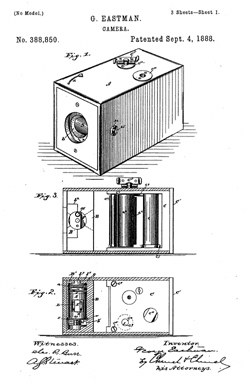 On September 4, 1888, George Eastman received patent #388,850 for a roll film camera. The camera called the”Kodak” was the beginning of snapshot photography. The ease of using this camera and its relatively inexpensive price of $25 dollars appealed to the middle class.
On September 4, 1888, George Eastman received patent #388,850 for a roll film camera. The camera called the”Kodak” was the beginning of snapshot photography. The ease of using this camera and its relatively inexpensive price of $25 dollars appealed to the middle class.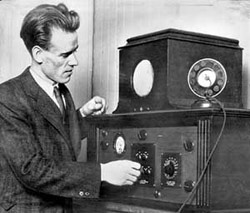 Philo Taylor Farnsworth was an American inventor born August 19, 1906. He was best known for inventing the first fully electronic television system, including the first working electronic image pickup device (video camera tube), and for being the first to demonstrate fully electronic television to the public.
Philo Taylor Farnsworth was an American inventor born August 19, 1906. He was best known for inventing the first fully electronic television system, including the first working electronic image pickup device (video camera tube), and for being the first to demonstrate fully electronic television to the public.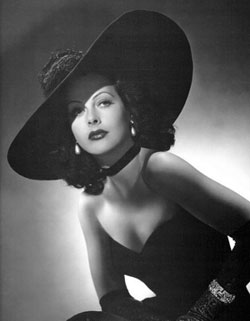 Hedy Lamarr was an Austrian-born American actress and scientist. Through her career as an actress, she was in more than 30 films including her biggest success as Delilah in Cecil B. DeMille’s Samson and Delilah, the highest-grossing film of 1949.
Hedy Lamarr was an Austrian-born American actress and scientist. Through her career as an actress, she was in more than 30 films including her biggest success as Delilah in Cecil B. DeMille’s Samson and Delilah, the highest-grossing film of 1949. On July 31, 1790, Samuel Hopkins of Pittsford, Vermont received the first U.S. patent for an improvement in “the making of Pot ash and Pearl ash by a new Apparatus and Process.” Pot Ash is a potassium carbonate used in the making soap and manufacturing of glass
On July 31, 1790, Samuel Hopkins of Pittsford, Vermont received the first U.S. patent for an improvement in “the making of Pot ash and Pearl ash by a new Apparatus and Process.” Pot Ash is a potassium carbonate used in the making soap and manufacturing of glass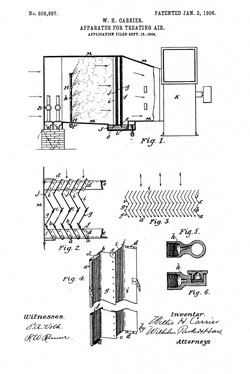 The next time you are enjoying an air conditioned movie theater, shopping mall or a cool room in your house, you should thank Willis Carrier. As a young engineer at New York’s Buffalo Forge Heating Company, Willis was tasked with solving a humidity-control problem at a Brooklyn printing plant.
The next time you are enjoying an air conditioned movie theater, shopping mall or a cool room in your house, you should thank Willis Carrier. As a young engineer at New York’s Buffalo Forge Heating Company, Willis was tasked with solving a humidity-control problem at a Brooklyn printing plant.